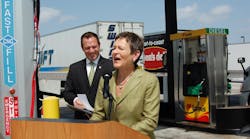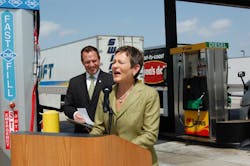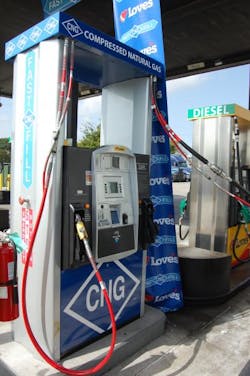[You can view more photos of the “fast fill” CNG rollout event by clicking here.]
I talked a little with Jenny Love Meyer, VP-communications for Love’s and daughter of founder Tom Love, about why “fast-fill” CNG is important in terms of spurring wider adoption of natural gas as a fuel for trucking operations.
Meyer (seen at right) told me “fast-fill” is critical for making trucking on natural gas within the “Texas Triangle” of Dallas, Houston and San Antonio as simple as trucking with diesel, in that CNG refueling stops within that critical trucking “triangle” conforms to the range limitations of trucks that run on natural gas.
“Obviously it’s a chicken and egg situation, in terms of what should come first: the [natural gas] vehicles or refueling locations,” she explained. “But we saw what was happening with the spread between natural gas and diesel [prices] and we knew there would be increased demand [for natural gas] so we wanted to be one of the first to provide it.”Indeed, CNG is available for $1.99 per equivalent gallon at Love’s Oak Cliff location right now, which is nearly $2 per gallon cheaper compared to the $3.85 being charged for diesel at the moment.
It also helps that Love’s core truck stop “footprint” throughout Oklahoma and Texas overlays the locations of major natural gas deposits in the U.S., she added.
[For more history about Love’s and its growth over the last 50 years, click here.]
So far, Love’s has five “fast fill” CNG locations within the “Texas Triangle” with plans to establish a network of 16 “fast fill” locations running from New Mexico through Arizona, Texas, Oklahoma, and up into Ohio.
[On a tangent, go here and here to get a feel for the work that goes on behind the scenes at a Love’s truck stop that offers maintenance services as well as fuel and food.]
The key is finding refueling points within the range of current CNG-powered equipment, Jim Decker, a terminal manager for Dillion Transport, explained to me at the event. Dillion operates a fleet of 400 trucks with 200 of them fired by CNG or liquefied natural gas (LNG). Some 50 of Dillion’s CNG tractors work in largely local bulk hauling operations out of the Dallas terminal serving the “Texas Triangle” region, with their typical length of haul at 530 to 540 miles.“We get a little extra mileage out of CNG compared to LNG but the biggest benefit is CNG is more user-friendly in terms of refueling,” he told me.
Indeed, one of the biggest benefits in the past with LNG is that such liquefied natural gas allowed for faster refueling, Decker added.
But now the “fast fill” pumps give CNG the same advantage, he pointed out, as “fast fill” technology pumps out CNG at a rate of 10 equivalent gallons per minute, meaning a driver can reload a 100 gallon equivalent tank in 10 minutes or less.
Of course, there are lots of other issues to be dealt with in order to make natural gas a true long-term alternative for trucking operations – with the high up-front acquisition costs for natural gas-powered commercial trucks just the tip of the iceberg.
We’ll just have to wait and see how the “gaseous” revolution in truck fuel alternatives plays out.






